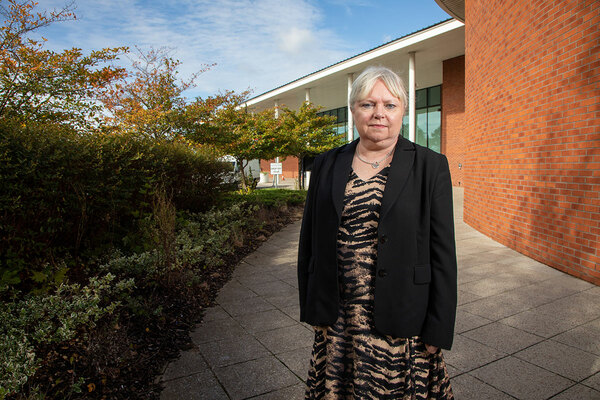We need to convince politicians to break down the barriers between housing, health and social care
Twenty-five years ago, Peter Walters became a housing and social services director – but he’s not sure we are much further forward today in terms of breaking down the national barriers between services. This must change for the well-being of people across the UK, he writes
We housing professionals might be frustrated by the lack of progress with our green paper, but at least we’ve got one.
The Social Care Green Paper, as yet unpublished but trailed in the Queen’s Speech in October, was first promised in March 2017 and has, according to The Guardian at least, been delayed six times in 18 months. With everything now on hold pending the election, that will make it seven.
For once Brexit is not to blame, or at least not entirely. The suspicion persists that such is the enormous cost to the only electorally tolerable solutions on the horizon, that the government is unable to bring itself to publish the reality.
You would think then that anything that might bring those costs down would, to say the least, have its attractions.
A few weeks ago, Julie Ogley, the admirable new president of the Association of Adult Directors of Social Services, joined a long line of professionals advocating greater co-operation between housing, health and social services in meeting the needs of our most vulnerable citizens, as well as simultaneously bringing down the ever-increasing costs of care.
Twenty-five years ago, more or less to the month, I became a housing and social services director in a London borough and we had high hopes of bringing about change, maximising our effectiveness for individuals, integrating services and achieving early interventions to maintain tenancies.
Five years later, little of it had happened and a further 20 years later, with the exception of sporadic but welcome beacons of excellence around the country, I’m not sure we are much further forward.
Indeed, if anything, prompted by government indifference and chronic shortage of funds, in many ways we have gone backwards. Will Julie see her vision through? I hope so – and I hope she drags health with her, too. But the auspices are not good. It’s a path littered with failed aspirations.
Why? And what can we do about it?
There are vast numbers of committed and motivated people working in housing and social services and across the health services. Many are cut from the same cloth, equally committed to improving the lives of vulnerable people. But integrated approaches need more than just dedication, well-meaning individuals and good will. The buzz phrase in the ‘90s was “joined-up thinking”, which still pops up in debate occasionally – not surprisingly because it’s still sorely lacking.
So much could be achieved. At the softer end, by identifying early indicators of need, social landlords, social services and health, working jointly can intervene to deliver preventative health and well-being work, enable people to maintain independence, and delay or prevent costly care placements.
Quite apart from using the expertise, eyes and ears of care and support providers in the housing sector, assistive technology can now detect unusual heat, light, humid or damp conditions, voice anxiety, stress, excessive noise or silence, as well as lack of movement in our homes. Health investment in technology helping to maintain tenancies longer must make financial sense.
And there is the perennial and nonsensical cost of bed-blocking. Everyone signs up to early discharge but few seem to have cracked the solution of providing and funding appropriate treatment at home, intermediate care homes with appropriate staffing, and live-in care to release much-needed in-patient beds for those who actually need it.
Specialist housing providers can provide post-discharge care in specialist but much cheaper provision than prolonged stays in hospitals and in conditions much more conducive to recovery, too.
Closer working could prioritise integrated service provision, mutual use of facilities and online resources. For all the substantial leaps forward in digital services for our residents now taking place in the sector, how many link with ease to social and health care services from which our residents could benefit?
And then there is integrating strategy at a national level. It’s tough. Just think: housing, social services and care have different funding streams, governance models and regulators. Housing associations are independent and nationally regulated. Councils oversee social services and social housing provision – yet even here, in many places, housing and social services are overseen by different local government tiers.
Care providers are regulated by the Care Quality Commission and the NHS is a complex mixture of top-down governmental strategy setting and local semi-independence. Overseeing all this is a government structure beleaguered by silo mentalities and the complications of politics.
“Housing providers are in a great position to deliver services to help ease the crises that both sectors face – but we can’t do it through inspired individuals alone”
As one housing association chief executive puts it: health and social care, through lack of resources and planning, are “too ragged to be creative and co-operative”. But it’s not all one way. A health and social care consultancy I know equally despairs at getting traction with housing associations to engage with health. Housing providers are in a great position to deliver services to help ease the crises that both sectors face – but we can’t do it through inspired individuals alone.
There have been efforts nationally of course and they are welcome. Improving health and care through the home: a national memorandum of understanding, first published in December 2014 and updated in March last year, is a thoroughly sensible document devised by all the lead organisations that have sign up to it, but as yet it’s hard to see across the board evidence of its impact. And in my work with a large number of housing association boards over the past couple of years, I don’t recall seeing it mentioned.
Maybe we need more eye catching evidence? Last month, Housing LIN (which tirelessly devotes itself to the cause of an integrated approach) and Southampton Council produced a report, Identifying the health care system benefits of housing with care, which did just that.
The study found benefits ranging from improvements to residents’ quality of life, reductions in the use of health services and associated resources, and significant cost benefits for the health system from the use of housing with care services. It was possible to estimate that for each person living in a home with care settings, the financial benefit to NHS was approximately £2,000 per person per annum (calculated as a costs benefit to the health care system).
A saving of £2,000 per annum per person? You wonder what more evidence is needed. But as one blogger, Chandra McGowan, chief executive of Whiteley Homes Trust, on the report put it: “None of this is rocket science, but the will to flexibly and creatively move resources to make it happen still feels as remote as the moon.”
“The barriers must be broken down, not just for the sake of efficiency and service quality but for the well-being of the people we jointly serve”
It’s a familiar litany. Much can be done by inspired individuals working across boundaries to achieve innovative services and excellent co-working. But the benefits of bringing health, social services and housing together won’t be delivered by individuals trying to achieve change in the face of inappropriate structures, funding and systems.
There are some great organisations and people – including those at Central & Cecil – who forge really excellent partnerships at local levels and are full of action and ideas, but equally there are hard-pressed professionals struggling to cope with the immense demands of the day job.
The lack of an overarching strategic direction means that breaking down the barriers is not just daunting but sometimes seems impossible. But the barriers must be broken down, not just for the sake of efficiency and service quality but for the well-being of the people we jointly serve.
Twenty-five years after my first engagement with health and social care, I’m back at the heart of it. I hope to achieve a lot more this time by supporting Housing LIN and all the other campaigners to make this work at last.
Perhaps on the subject of housing, care and health, there should be just one green paper. The prize is too great to ignore and so are the potential savings – politicians take note.
Peter Walters, chair, Central & Cecil Housing Trust











